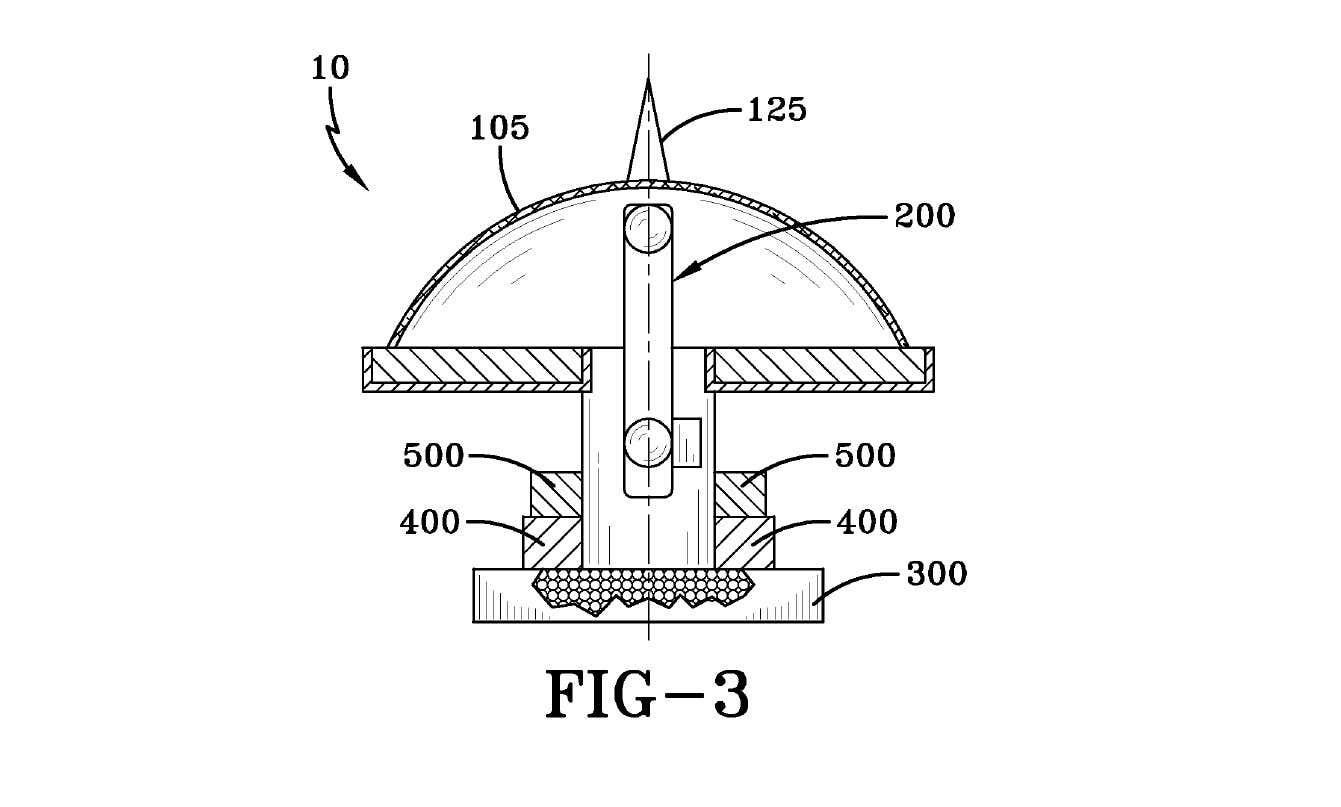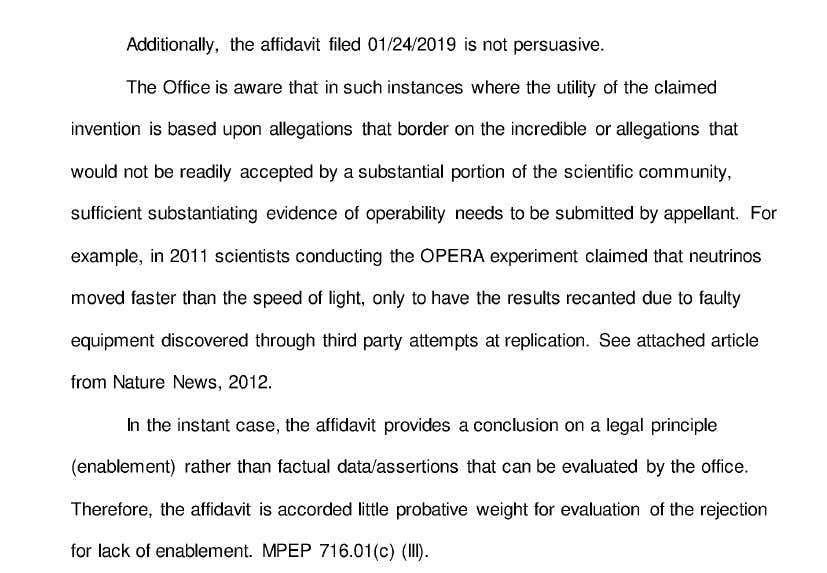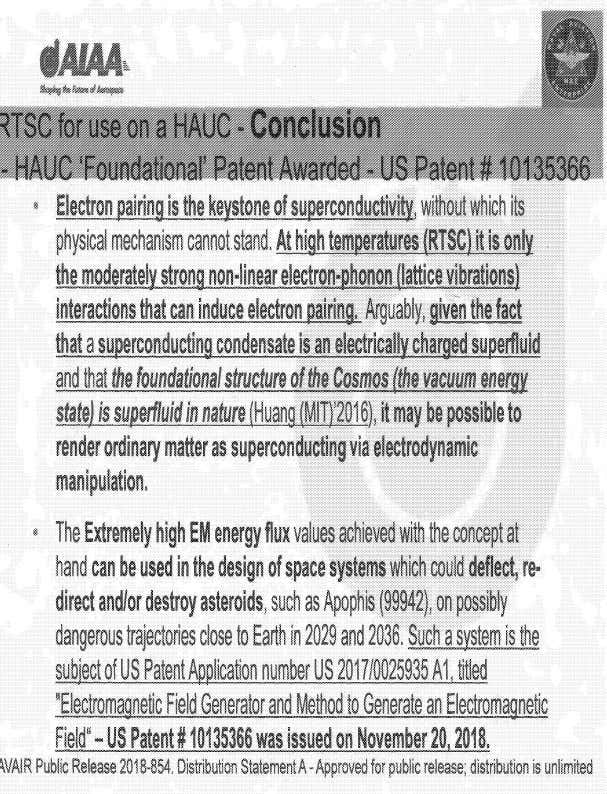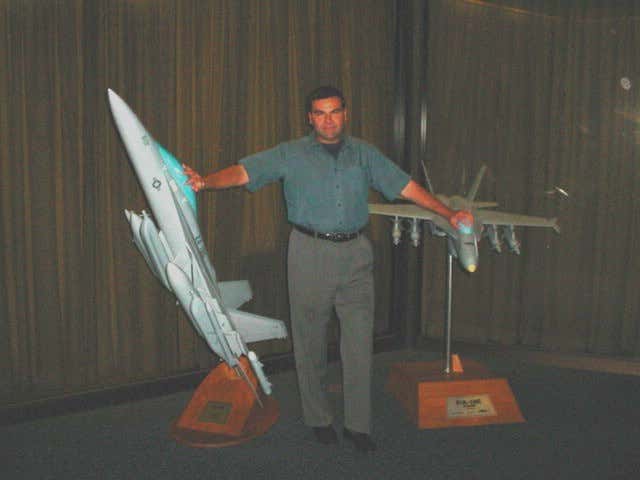
はじめに
海軍の先端航空宇宙技術のボスは、重要な「UFO」特許は操作可能だと主張している
Navy's Advanced Aerospace Tech Boss Claims Key 'UFO' Patent Is Operable
Navy officials claim their radical electromagnetic and superconductor technologies aren't theoretical, they’re already operable in some form.
海軍関係者は、彼らの革新的な電磁技術や超伝導技術は理論的なものではなく、すでに何らかの形で利用可能であると主張している。
By Brett Tingley August 2, 2019
投稿者 BrettTingley:2019年8月2日
Last month, The War Zone reported on a series of strange patent applications the U.S. Navy has filed over the last few years and questioned what their connections may be with the ongoing saga of Navy personnel reporting incidents involving unidentified objects in or near U.S. airspace.先月、『The War Zone』は、米海軍が過去数年間に提出した一連の奇妙な特許出願について報告し、米空域内またはその近くでの未確認物体に関わる事件を報告している海軍関係者の現在進行中の物語との関連性を疑問視しました。www.thedrive.comwww.thedrive.comwww.thedrive.comWe have several active Freedom of Information Act requests with the Department of Navy to pursue more information related to the research that led to these patents. As those are being processed, we've continued to dig through the U.S. Patent and Trademark Office's (USPTO) Public Patent Application Information Retrieval database to get as much context for these patents as possible.私たちは、これらの特許につながった研究に関連するより多くの情報を追求するために、海軍省にいくつかの情報公開法(Freedom of Information Act)の要請をしています。これらの要求が処理されている間、米国特許商標庁(USPTO)の公開特許出願情報検索データベースを調査して、これらの特許についてできるだけ多くの情報を得るようにしています。In doing so, we came across documents that seem to suggest, at least by the Navy's own claims, that two highly peculiar Navy patents, the room temperature superconductor (RTSC) and the high-energy electromagnetic field generator (HEEMFG), may in fact already be in operation in some manner. The inventor of the Navy's most bizarre patent, the straight-out-of-science fiction-sounding hybrid aerospace/underwater craft, describes that craft as leveraging the same room temperature superconductor technology and high energy electromagnetic fields to enable its unbelievable speed and maneuverability. If those two technologies are already operable as the Navy claims, could this mean the hybrid craft may also already operable or close to operable? Or is this just more evidence that the whole exotic 'UFO' patent endeavor on the Navy's behalf is some sort of ruse or even gross mismanagement of resources?そうするうちに、私たちは、少なくとも「海軍自身の主張」によって、二つの非常に独特な海軍特許である「室温超伝導体 (RTSC)」 と「高エネルギー電磁界発生器 (HEEMFG) 」が、実際に「何らかの形ですでに稼働しているかもしれない」ことを「示唆しているように見える」文書に出くわした。米海軍の最も奇抜な特許の発明者である、まったく科学的ではないフィクションのように聞こえる「航空宇宙/水中複合型宇宙船」は「室温超伝導技術と高エネルギー電磁界を利用して、信じられないほどの速さと機動性を実現している」と説明している。海軍が主張しているように、それら二つの技術が既に操作可能であるならば、これはハイブリッド機も既に操作可能か、操作可能に近いかもしれないことを意味しているのでしょうか?それとも、海軍のために行われているエキゾチックな「UFO」特許の努力が、ある種の策略か、あるいは資源の無駄遣いであることを示す、より多くの証拠なのでしょうか?patents.google.compatents.google.comarc.aiaa.orgMake sure to read our last feature on this bizarre topic to get up to speed on critical background information before continuing on.この奇妙なトピックについての最新の特集を読んで、重要な背景情報を把握してから次に進むようにしてください。www.thedrive.com(訳注)既に和訳した記事はコチラkazzhirock.hatenablog.jp海軍の特許と主張される運用性
The Navy’s patents and their alleged operability
At the heart of these questions is the term “operable.” In most patent applications, applicants must assert proof of a patent’s or invention’s “enablement,” or the extent to which a patent is described in such a way that any person who is familiar with similar technologies or techniques would be able to understand it, and theoretically reproduce it.
これらの問題の核心は、「運用可能」という用語です。ほとんどの特許出願では、出願人は、特許または発明の「可能性」、すなわち、類似の技術や技術に精通している人であれば「誰でも理解でき、理論的に再現できるような方法で特許が記述されていることの証明」を主張しなければなりません。
However, in these patent documents, the inventor Salvatore Pais, Naval Air Warfare Center Aircraft Division's (NAWCAD) patent attorney Mark O. Glut, and the U.S. Naval Aviation Enterprise's Chief Technology Officer Dr. James Sheehy, all assert that these inventions are not only enabled, but operable. To help me understand what that term may mean in these contexts, I reached out to Peter Mlynek, a patent attorney.
しかし、これらの特許文書では、発明者Salvatore Pais、海軍航空戦センター航空機部門 (NAWCAD) の特許弁護士Mark O.Glut、および米国海軍航空企業の最高技術責任者Dr.James Sheehyのすべてが、これらの発明は可能であるだけでなく、操作可能であると主張している。このような状況でこの用語が何を意味するのかを理解するために、私は特許弁護士のPeter Mlynek氏に連絡を取った。
Mlynek informed me that the terms “operable” or “operability” are not common in patent applications, but that there is little doubt that the use of the term is meant to assert to the USPTO that these inventions actually work:
Mlynek氏は、「運用可能」や「運用性」という用語は特許出願では一般的ではないが、この用語の使用は、これらの発明が実際に機能することをUSPTOに主張するためのものであることはほとんど疑う余地がないと教えてくれた。
"Generally, patent applications are rejected on the basis of enablement more frequently than for operability. The Patent Office rejects patent applications based on enablement because the patent attorney did not describe the invention fully, because either the patent attorney did a sloppy job, or the patent attorney caved to the client's pressure to disclose as little about the invention as possible.
"Operability/operative, on the other hand, means that the invention actually works. From what I've seen, operability rejection comes up in cases where the patent attorney does not really understand the science or technology behind the invention. In many cases, the rejection based on inoperability is a kind of way of telling the patent attorney that the attorney has no idea what he/she is talking about."
一般的に、特許出願は、操作性よりも実施可能性を理由に却下されることが多い。特許庁が実施可能性に基づいて特許出願を却下するのは、弁理士が発明を十分に説明しなかったからであり、弁理士がずさんな仕事をしたか、または弁理士がクライアントからの発明の開示をできるだけ少なくするようにとの圧力に屈したからである。
"一方、運用性/運用可能とは、発明が実際に機能することを意味します。私が見てきたところでは、弁理士が発明の背後にある科学や技術を本当に理解していない場合には、操作性拒絶反応が出てきます。多くの場合、操作不能に基づく拒絶は、弁理士が何を言っているのか全く理解していないことを弁理士に伝えるための一種の方法である。
All of these technologies - the room temperature superconductor, the high-energy electromagnetic field generator, and the hybrid aerospace/underwater craft (HUAC) - are inventions of the same NAWCAD aerospace engineer, the aforementioned Salvatore Cezar Pais. Our previous article on the Navy’s patents explored the hybrid craft and whether or not it could be related to other developments such as Navy pilots reporting strange objects in U.S. airspace during training exercises and members of Congress now asking for answers on UFOs.
これらすべての技術 - 室温超伝導体、高エネルギー電磁場発生器、およびハイブリッド航空宇宙/水中クラフト(HUAC) - は、同じ NAWCAD の航空宇宙技術者である前述のサルバトーレ・セザール・パイスの発明である。海軍の特許に関する私達の以前の記事では、ハイブリッドクラフトと、訓練訓練中に米国の空域で奇妙な物体を報告する海軍のパイロットや、現在UFOについての回答を求めている議会のメンバーのような他の開発に関連しているかどうかを探りました。
サルバトーレ・パイスは世界を救いたいと思っている
Salvatore Pais wants to save the world
In a conference paper that Pais presented earlier this year at the 2019 American Institute of Aeronautics and Astronautics (AIAA) SciTech Forum in San Diego, the inventor states that the research that led to all of these technologies was funded by a single Naval Innovative Science & Engineering (NISE) – Basic & Applied Research (BAR) program, titled “The High Energy Electromagnetic Field Generator (HEEMFG).”パイス氏が今年初めにサンディエゴで開催された2019年アメリカ航空宇宙学会(AIAA)のSciTechフォーラムで発表した会議論文の中で、本発明者は、これらの技術のすべてにつながる研究は、"高エネルギー電磁界発生器(HEEMFG)"と題された単一のNaval Innovative Science & Engineering(NISE)-Basic & Applied Research(BAR)プログラムによって資金提供されたと述べています。In the Navy’s patent application for the HUAC, it’s claimed that the radical abilities of propulsion and maneuverability are made possible thanks to an incredibly powerful electromagnetic field that essentially creates a quantum vacuum around itself that allows it to ignore aerodynamic or hydrodynamic forces and remove its own inertial mass from the equation. Thus, the ability to generate such high-frequency electromagnetic waves is key to the alleged abilities of this theoretical hybrid craft that can soar near effortlessly through air and water at incredible speeds with little to no resistance or inertia.HUACのための海軍の特許申請では、推進力と操縦性の根本的な能力が、信じられないほど強力な電磁場のおかげで可能になったと主張されています。このように、そのような高周波電磁波を生成する能力は、ほとんど抵抗や慣性を持たずに、信じられないほどの速度で空気や水を通って、ほぼ楽々と舞い上がることができる、この理論的なハイブリッドクラフトの疑惑の能力への鍵となります。In the patent application documents for the HEEMFG, we came across a record of an interview requested by Pais and the Navy as part of the appeal process for the patent’s initial rejection. During this telephone interview, which took place on July 10, 2018, Pais and the Navy’s attorney presented evidence that the high energy electromagnetic field generator was, in fact, operable and was a “formative invention in its incipient stage(s).”HEEMFGの特許出願書類の中で、私たちは、特許の最初の拒絶反応に対する上訴プロセスの一環として、パイス博士と海軍が要求した電話インタビューの記録に出くわした。2018年7月10日に行われたこの電話インタビューの間に、パイス博士と海軍の弁護士は、高エネルギー電磁界発生器が実際には操作可能であり、"その初期段階の形成的な発明 "であったという証拠を提示した。
In the patent for the HEEMFG, the technology is described as being able to create what is essentially a force field straight out of science fiction, one that could generate “an impenetrable defensive shield to sea and land as well as space-based military and civilian assets, protecting these assets from such threats as Anti-Ship Ballistic Missiles, Radar Evading Cruise Missiles, Top Attack for Main Battle Tanks (land and sea-based systems), as well as counteracting the effects of solar-induced Coronal Mass Ejections or defending critical military satellites in an ASAT [anti-satellite] role (space based system).”HEEMFGの特許によると、この技術はSF小説に出てくるような「対艦弾道ミサイル、レーダー回避巡航ミサイル、主戦車に対するトップ攻撃(陸上・海上システム)などの脅威からこれらの資産を保護するとともに、太陽誘導のコロナ質量放出の影響を打ち消し、ASATの役割の中で重要な軍事衛星を防衛する、海と陸だけでなく、宇宙ベースの軍事資産や民間資産に対する不可侵の防衛シールド(宇宙ベースシステム)」を生み出す力の場を作り出すことができるという。
An image of the high energy electromagnetic field generator from the patent depicting its shell composed of "embedded polycrystalline ferroelectric ceramic material" capable of exhibiting "strong Piezoelectric Effects" (105), an electrostatic generator (200), a nuclear fission pebble bed reactor (300), a thermoelectric generator (400), and an electric motor (500). The protrusion at the top (125) is claimed to "generate a Cyclonic Plasma shield, which would greatly amplify the produced electromagnetic field intensity."この特許に記載されている高エネルギー電磁界発生器の画像は、そのシェルが、「埋め込み多結晶強誘電セラミック材料」を示すことができる「強力な圧電効果」 (105) 、静電発生器 (200) 、核分裂ペブルベッド反応器 (300) 、熱電発生器 (400) 、及び電気モーター (500) から構成されていることを示している。上部 (125) の突起は、「発生する電磁界強度を大幅に増幅するサイクロニックプラズマシールドを発生させる」とされている。
In his presentation at the 2019 AIAA SciTech Forum, Pais claims that this device could even serve as an optimal asteroid deflector to save the world from 99942 Apophis, a 370-meter diameter near-Earth asteroid which has been predicted to come dangerously close to our planet in 2029 and 2036.2019年AIAA SciTech Forumでの発表で、パイス博士は、このデバイスは、2029年と2036年に我々の惑星に危険なほど接近すると予測されている直径370メートルの地球近傍小惑星「99942 Apophis」から世界を救うための最適な小惑星偏向装置としても機能すると主張している。While saving the world from a massive asteroid is without a doubt a worthwhile application of this alleged high energy electromagnetic field generator, the military applications of this supposed technology would give a paradigm-exploding advantage to any military wielding such an impenetrable electromagnetic force field. Is it only a hypothetical technology, though? The inventor and his attorney assured the patent office it is indeed operable, at least to some degree.巨大な小惑星から世界を救うことは、この主張されている高エネルギー電磁界発生器の価値ある応用であることは間違いないが、この想定された技術の軍事的応用は、このような不可解な電磁力場を行使するいかなる軍隊にもパラダイム爆発的な利点を与えるだろう。しかし、これは単なる仮想技術なのだろうか?発明者とその弁護士は、特許庁に対して、少なくともある程度は実際に運用可能であることを保証した。Many readers have also questioned whether or not Salvatore Cezar Pais is, in fact, a real person. In our search for information about the elusive inventor, we have found a few mentions in one of his alma mater's class notes updates, which states that Pais obtained his undergraduate degree in 1990 and a graduate degree in 1993 in mechanical engineering. The Mathematics Genealogy Project, meanwhile, states he obtained his Ph.D. from Case Western Reserve University in 1999.読者の中には「サルバトーレ・セザール・パイスは実在の人物なのか?」と疑問を持つ人も多いだろう。このとらえどころのない発明家についての情報を探すうちに、Paisが「1990年に学部の学位を、1993年に機械工学の大学院の学位を取得した」と述べている母校のクラスノートの更新の一つに、いくつかの言及を見つけた。一方、Mathematics Genealogy Projectは、1999年にCase Western Reserve Universityから博士号を取得したと述べている。We also came across this image purporting to depict Pais on a Chinese news blog which covered our original patent story, but we have so far been unable to ascertain its veracity. However, a smaller version of the same picture appears on a U.K.-based book review site under the author name Salvatore Cezar Pais.我々はまた、我々の元の特許の話をカバーした中国のニュースブログでパイス博士を描写しているとされているこの画像を見つけたが、我々は今のところその真実性を確認することができない。しかし、同じ絵を縮小したものが、イギリスの書評サイトにSalvatore Cezar Paisという著者名で掲載されている。A supposed image of Salvatore Pais standing among large Super Hornet and Growler models.大型のスーパーホーネットモデルとグローラーモデルの間に立っているサルバトーレ・パイスの想定画像。海軍のCTOがパイスの室温超伝導体は運用可能だと主張
Navy CTO claims Pais’ room temperature superconductor is operable
While the HEEMFG sounds like pure science fiction, another one of Pais’ patents may be somewhat closer to reality, depending on who you ask. For years, scientists have sought to create room-temperature superconductors, electrical circuits with zero resistance that generate powerful electromagnetic fields.HEEMFGは純粋なサイエンスフィクションのように聞こえますが、 パイスの特許のもう一つは、 誰に聞くかによっては、現実に近いものになるかもしれません。何年もの間、科学者たちは常温の超電導体、つまり強力な電磁場を発生させる抵抗ゼロの電気回路を作ろうとしてきました。
Most superconductors require incredibly low temperatures, however, making them impractical for most uses outside of laboratories or other carefully controlled environments. As noted by Pais in his 2019 AIAA presentation, "the achievement of room-temperature superconductivity (RTSC) represents a highly disruptive technology, capable of a total paradigm change in Science and Technology,” and adds that its “military and commercial value is considerable."しかし、ほとんどの超電導体は信じられないほどの低温を必要とするため、研究室やその他の慎重に管理された環境以外ではほとんどの用途では実用的ではない。2019年のAIAAのプレゼンテーションでパイス博士が指摘したように、"室温超電導(RTSC)の達成は、科学技術の総パラダイムの変化を可能にする、非常に破壊的な技術を表している "と述べ、その "軍事的および商業的価値はかなりのものである "と付け加えています。
Several recent experiments into room temperature or high-temperature superconductivity have had some preliminary success, which suggests this once-out-of-reach technology could possibly become obtainable with further research. A 2019 Nature article summarizing results with room temperature superconductivity under high pressure states that "it seems more likely than ever that the dream of room-temperature superconductivity might be realized in the near future" and that "experimental data now confirm superconductivity at higher temperatures than ever before."Nevertheless, Pais’ room temperature superconductor patent was rejected under 35 U.S.C. 101 because the examiner determined “the disclosed invention is inoperative and therefore lacks utility” and that “no assertions of room-temperature superconductivity have currently been recognized or verified by the scientific community.”室温または高温超電導へのいくつかの最近の実験は、いくつかの予備的な成功を収めており、この一度は手の届かなかった技術が、さらなる研究によって得られる可能性があることを示唆している。高圧下での室温超電導の結果をまとめた2019年のNatureの論文では、「室温超電導の夢が近い将来実現する可能性がこれまで以上に高いと思われる」とし、「実験データは現在、これまで以上に高温での超電導を確認している」としている。 "それにもかかわらず、パイス博士の室温超電導体特許は35 U.S.C.101に基づいて却下された。それは、審査官が「開示された発明は操作不能であり、したがって実用性を欠いている」と判断したからであり、「室温超電導の主張は、現在のところ科学界によって認められていないか、または検証されていない」からである。www.nature.com
That code states that patents will be granted only for "any new and useful process, machine, manufacture, or composition of matter, or any new and useful improvement thereof." According to the Manual of Patent Examining Procedure (MPEP) code 2164.07, patents are rejected on these grounds in cases “when the examiner concludes that an application claims an invention that is non-useful, inoperative, or contradicts known scientific principles.”このコードでは、特許が付与されるのは、「新規で有用なプロセス、機械、製造、物質の構成、またはそれらの新規で有用な改良」のみであるとされている。特許審査手続マニュアル(MPEP)コード2164.07によると、このような理由で特許が却下されるのは、「審査官が、出願が有用でない、操作不能、または既知の科学的原理に矛盾する発明を主張していると結論付けた場合」であるとされています。www.uspto.govFollowing that rejection, Naval Aviation Enterprise Chief Technology Officer Dr. James Sheehy once again stepped in to write a letter to the USPTO personally to vouch for the room temperature superconductor, going so far as to declare that the RTSC is “operable and enabled via the physics described in the patent application” and Pais’ publications. Again, the keyword here is “operable,” which has a different meaning than simply “enabled.”
その拒絶に続いて、Naval Aviation Enterpriseの最高技術責任者であるJames Sheehy博士は、再びUSPTOに個人的に室温超電導体を保証するために手紙を書き、RTSCが「特許出願に記載された物理学によって操作可能であり、有効である」とパイス博士の出版物を介して宣言するまでになりました。繰り返しになりますが、ここでのキーワードは "運用可能 "であり、単に "有効 "とは異なる意味を持っています。Sheehy assures the examiner that he is “well versed in the generation of electromagnetic fields, high temperature super conductivity, and physics in general.” Note, too, the last line: Sheehy’s declaration was made with the knowledge that false statements to the USPTO are punishable by fine or imprisonment.Sheehy’s letter was accompanied by a statement from Naval Aviation Enterprise attorney Mark Glut in which Glut states that “Sheehy states the invention is operable and enabled, thus overcoming both rejections."
シーヒーは試験官に "電磁場の発生、高温超伝導、物理学全般に精通している "と断言しています。最後の行にも注目してください。Sheehyの手紙には、Naval Aviation Enterpriseの弁護士Mark Glutの声明が添付されており、その中でGlutは、"Sheehyは、発明は操作可能であり、可能であると述べており、したがって、両方の拒絶を克服する "と述べています。In a separate appeal document, Glut states that in the case of the RTSC patent, “there is no reason to doubt the truth of the statements contained in the specification” and that the patent office “must provide a factual basis for an enablement rejection, rather than conclusory statements regarding the state of conventional scientific theory.”
別の控訴文書では、Glutは、RTSC特許の場合、「明細書に記載されている記述の真実性を疑う理由はない」とし、特許庁は「従来の科学的理論の状態に関する結論的な記述ではなく、可能性のある拒絶のための事実に基づく根拠を提供しなければならない」と述べている。Glut goes even further with somewhat of a dig at USPTO examiner Paul A. Wartalowicz, writing that in the case of this rejection, “the examiner turned to perceived mainstream science to indicate the concept was not possible” but that “in this matter, the gatekeepers of science (the peer reviewers of Applicant’s papers) indicated the concept is possible and enabled.”
Glutはさらに、USPTOの審査官Paul A. Wartalowiczを少しだけ批判して、この拒絶の場合には、「審査官は、コンセプトが不可能であることを示すために、知覚された主流の科学に目を向けた」が、「この問題では、科学の門番(出願人の論文の査読者)は、コンセプトが可能であり、可能であることを示した」と書いています。However, it's important to note that while many of Pais' publications were published in peer-reviewed journals, his most recent publication wasn’t actually peer-reviewed. The publication “Room Temperature Superconducting System for use on a Hybrid Aerospace-Undersea Craft” does not appear in a peer-reviewed journal, but was instead presented at the 2019 AIAA SciTech Forum. On the AIAA’s Abstract Submission Process & Requirements page, it is stated that “All abstracts will be evaluated by qualified individuals from industry, academia, or government. It is recommended to the Technical Program Committee to have the broadest representation of reviewers appropriate for the forum/conference. Exceptions may be made for invited abstracts. Please note that this is a review of abstracts only and that AIAA’s meeting papers are not peer-reviewed.” Thus, the statements made by the Navy attorney aren’t entirely accurate.
しかし、パイス博士の出版物の多くは査読付きジャーナルに掲載されていたが、彼の最新の出版物は実際には査読付きではなかったことに注意が必要である。出版物「Room Temperature Superconducting System for use on a Hybrid Aerospace-Undersea Craft」は、査読付きジャーナルには掲載されておらず、代わりに2019 AIAA SciTech Forumで発表されている。AIAAのアブストラクト投稿プロセスと要件のページには、「すべてのアブストラクトは、産官学の有資格者によって評価されます」と記載されています。フォーラム/会議に適した審査員の代表者を最も広く配置することが技術プログラム委員会に推奨されています。招待された演題については例外となる場合があります。これは抄録のみのレビューであり、AIAA の会議論文は査読されていないことに注意してください" このように、海軍の弁護士の発言は完全には正確ではありません。 A slide from Pais' 2019 presentation "Room Temperature Superconducting System for use on a Hybrid Aerospace-Undersea Craft."パイスの2019年発表会 "ハイブリッド航空宇宙・海底探査機で使用するための室温超電導システム "のスライドです。
A slide from Pais' 2019 presentation "Room Temperature Superconducting System for use on a Hybrid Aerospace-Undersea Craft."パイスの2019年発表会 "ハイブリッド航空宇宙・海底探査機で使用するための室温超電導システム "のスライドです。
In another one of the correspondences between the USPTO and the Navy regarding the Room Temperature Superconductor patent, the examiner writes that “in such instances where the utility of the claimed invention is based upon allegations that border on the incredible or allegations that would not be readily accepted by a substantial portion of the scientific community, sufficient substantiating evidence of operability needs to be submitted by appellant.” 室温超電導体特許に関するUSPTOと海軍との間の別の通信には、審査官は、「クレームされた発明の実用性が、信じられないような主張や、科学界の大部分が容易に受け入れられないような主張に基づいている場合には、操作性についての十分な立証証拠を控訴人が提出する必要がある」と書いています。 USPTOFollowing that rejection, Pais and NAWCAD’s patent attorney Mark Glut requested a telephone interview that took place on June 6, 2019. According to the USPTO’s public database, the appeals surrounding the room temperature superconductor are still ongoing despite the declarations made by Dr. James Sheehy and attorney Mark Glut.その拒絶反応を受けて、パイス博士とNAWCADのMark Glut弁護士は、2019年6月6日に行われた電話インタビューを要求した。USPTOの公開データベースによると、James Sheehy博士とMark Glut弁護士が宣言したにもかかわらず、常温超電導体をめぐる控訴は続いている。
USPTOFollowing that rejection, Pais and NAWCAD’s patent attorney Mark Glut requested a telephone interview that took place on June 6, 2019. According to the USPTO’s public database, the appeals surrounding the room temperature superconductor are still ongoing despite the declarations made by Dr. James Sheehy and attorney Mark Glut.その拒絶反応を受けて、パイス博士とNAWCADのMark Glut弁護士は、2019年6月6日に行われた電話インタビューを要求した。USPTOの公開データベースによると、James Sheehy博士とMark Glut弁護士が宣言したにもかかわらず、常温超電導体をめぐる控訴は続いている。 USPTO
USPTO巨大なジャンボと洗練されたせせらぎの威圧的な川
An intimidating river of mumbo-jumbo and sophisticated babble
After our last article on these bizarre Navy Patents, and the hybrid craft patent, in particular, some readers were quick to point out that like the physicists I have spoken with while researching these patents, they are unconvinced that the Navy may have actually already developed, or even could develop, radical new forms of electromagnetic propulsion or the room-temperature superconductors the patents and their related publications describe as the key component in their operability. To help contextualize the science or pseudoscience behind these patents and what it may or may not signify, I spoke with Dr. Mark Gubrud, a University of North Carolina physicist who teaches Peace, War & Defense courses and whose PhD is in ultra-low temperature and nanoscale experimental physics. Like many physicists, Gubrud has for years encountered claims of room-temperature superconductors and so-called spacetime metric engineering:これらの奇妙な海軍特許、特にハイブリッド機の特許についての前回の記事の後、何人かの読者は、私がこれらの特許を調査している間に話をした物理学者のように、海軍が実際にすでに開発しているかもしれない、あるいは開発する可能性があるかもしれない、ということを素早く指摘してくれました。これらの特許の背後にある科学や疑似科学、そしてそれが何を意味するのか、あるいは何を意味しないのかを文脈に沿って説明するために、ノースカロライナ大学の物理学者で、平和、戦争、防衛のコースを教え、超低温とナノスケールの実験物理学の博士号を持つマーク・グブルド博士に話を聞いた。多くの物理学者と同様に、グブルド博士は室温超伝導体といわゆる時空メトリック工学の主張に長年遭遇してきました。arxiv.org
"In the past, I have attended conferences of 'free energy' and 'cold fusion' cranks, and encountered very similar claims. The claim to have developed, or know how to develop, a room-temperature superconductor is a perennial; so are claims based on some woolly physics to alter space, inertial mass or the laws of motion. One sees these things at the meetings and in the publications that constitute a crackpot hobby industry which is mostly about the vanity of its participants."Pais's patents flow as an intimidating river of mumbo-jumbo that most trained physicists would recognize as nonsense, although many might simply disengage in confusion, and there are always some who might even be credulous. Of what, however, is hard to say, as it is not really clear what Pais is even claiming, apart from the room-temperature superconductor which, if it were true, would be huge news."Pais deploys fairly sophisticated babble to make this sound plausible to those who know what real physics sounds like, but don't understand much of it. Which is likely to include most patent examiners, journalists, and Pais's own enablers in the Navy." 過去に、私は「フリーエネルギー」と「冷核融合」の会議に出席したことがありますが、非常に似たような主張に遭遇しました。室温超伝導体を開発した、あるいは開発する方法を知っているという主張は毎年のことであり、空間や慣性質量、運動法則を変えるために、いくつかの毛むくじゃらな物理学に基づいた主張も同様です。ペイスの特許は、訓練を受けた物理学者ならば、ほとんどの人がナンセンスだと認識するだろうが、多くの人は単に混乱して目を逸らすだけで、中には信じてしまう人もいるかもしれない。ペイス氏が主張している室温超伝導体は別として、もしそれが本当ならば大きなニュースになるだろうが、何を主張しているのかははっきりしないので、何とも言えない。それは、ほとんどの特許審査官、ジャーナリスト、そして、ペイス自身の海軍のお偉方も含まれているでしょう。
I asked for Gubrud’s opinion on why Dr. James Sheehy would vouch for Pais’ patents, to which he replied that it’s likely someone at NAWCAD has been misled or fooled:
私は、ジェームズ・シーヒー博士が「なぜパイス博士の特許を保証するのか?」についてグブルド氏の意見を求めたところ「NAWCAD の誰かが騙されたのではないか?」との答えが返ってきました。
"I don't know why Sheehy defended Pais's patents. I am certain it's not because they really make some kind of sense. I suspect the story is just one professional charlatan who has embedded himself in the Naval Air Warfare Center Aircraft Division, plus one or a few supervisors he's managed to fool. It's possible, of course, that it is a bigger story which involves some actual 'experiments' and expenditure of funds, which is now being protected from scrutiny."
「シーヒーがなぜパイスの特許を擁護したのか私にはわからない。私はそれが本当に何らかの意味を持つからではないと確信しています。私が思うに、この話は、海軍航空戦センターの航空機部門に身を潜めている1人のプロのペテン師と、彼が騙すことに成功した1人か2、3人の監督者だけの話ではないでしょうか。もちろん、それが実際の「実験 」と資金の支出を含むより大きな物語であり、現在精査から保護されていることは可能である。」
Ultimately, Guburd believes the patents signify nothing more than “an illustration of the need for transparency and peer review,” but that “even with such niceties, nonsense gets funded, often for political and ideological reasons, or simply out of corruption. But nonsense seems an especially hardy perennial in hierarchical, closed and secretive organizations.”
このように、この特許は「透明性とピアレビューの必要性を示すもの」に過ぎないが、「そのような優美さを持っていても、しばしば政治的・思想的な理由で、あるいは単に汚職のために、無意味な資金が提供されることがある」とグブルド氏は考えている。しかし、無意味なことは、階層的で閉鎖的で秘密主義的な組織では、特に丈夫な多年草のように思われます。
特許の武器化
Weaponizing patentsDespite months of research and FOIA requests, it’s still unclear why the Navy would go to bat so vehemently for these patents which, as another physicist I spoke with put it, “bear no more resemblance to quantum physics as I understand it than does ‘The Force’ from Star Wars."何ヶ月にもわたる研究とFOIAの要請にもかかわらず、私が話をした他の物理学者が言うように、 「スターウォーズの『フォース』ほど量子物理学に似ていない」 これらの特許をなぜ海軍がこれほど激しく攻撃するのかはまだ不明である。
If the Navy has indeed managed to develop operable room temperature superconductors and electromagnetic force fields, these technologies would revolutionize warfare in ways not seen in centuries, or maybe even ever, not to mention leading to paradigm changes in civilian technology. Yet the largest question remains: if the Navy indeed possesses these technologies, or even thinks they are obtainable in the near term, why make the patents public?
海軍が本当に運用可能な室温超電導体と電磁力場の開発に成功したとすれば、これらの技術は、民間技術のパラダイム変化につながることは言うまでもなく、何世紀にも、いや、これまでにない方法で戦争に革命をもたらすことになるでしょう。しかし、最大の疑問は、海軍がこれらの技術を本当に保有しているのか、あるいは近い将来に入手可能だと考えているのか、なぜ特許を公開するのか、ということです。
With all this in mind, it's certainly possible that these patents are part of some ongoing information campaign designed to make America’s competitors question what types of black budget research is currently underway at NAWCAD and other research organizations. With so many revolutionary new aerospace technologies on the brink of deployment, perhaps this is an attempt to essentially “weaponize” patents and sow doubt among our adversaries and even inject confusion among the American populace.
これらのことを考えると、これらの特許が、現在NAWCADや他の研究機関でどのような種類のブラックバジェット研究が行われているのか、アメリカの競争相手に疑問を持たせるために行われている情報キャンペーンの一部である可能性は確かにある。これほど多くの革命的な新しい航空宇宙技術が配備されようとしている今、おそらくこれは本質的に特許を 「兵器化」 しようとする試みであり、われわれの敵に疑念を植え付け、さらには米国民に混乱をもたらすことにさえなるだろう。
www.thedrive.comwww.thedrive.comwww.thedrive.com
That scenario seems more likely given the fact that the Naval Aviation Enterprise Chief Technical Officer Dr. Sheehy claimed Chinese advances in similar capabilities as a means of getting the hybrid aerospace/underwater craft patent application approved. The U.S. and China are in a new technological arms race to develop the next generations of aircraft and advanced weaponry. Part of this race includes producing disinformation and misinformation to make your enemy invest resources, both intelligence and research and development related, that are, for lack of a better word, dead-ends.
このシナリオは、海軍航空企業最高技術責任者のシーヒー博士が、ハイブリッド航空宇宙/水中機の特許出願を承認させる手段として、中国の同様の能力の進歩を主張していることを考えると、より可能性が高いように思われる。米国と中国は、次世代の航空機と高度な兵器を開発するために、新たな技術の軍拡競争を繰り広げている。この競争の一部には、敵に諜報活動や研究開発関連の資源を投資させるための誤報や誤情報を流すことが含まれているが、これは言葉は悪いが、行き詰まりである。
www.thedrive.comwww.thedrive.comwww.thedrive.com
Being able to explain away strange objects in the sky as UFOs, which may indeed be emerging classified capabilities, is also beneficial both here at home and abroad. Overall, these patents certainly add to an increasingly complex narrative mosaic that is emanating directly from the Navy, one that began just as a new era of so-called 'great power competition' was being declared at the highest rungs of the Pentagon's leadership.
UFOとして空の奇妙な物体を説明することができるということは、確かに新たな機密扱いの能力であるかもしれませんが、国内でも海外でも有益です。全体的に見て、これらの特許は、いわゆる「大国間の競争 」の新時代がペンタゴンの指導部の頂点で宣言されたちょうどその時に始まった、海軍から直接発せられるますます複雑になりつつある物語のモザイクに確実に追加する。
At the same time, maybe this is the Pentagon's grasping attempt to try to make sense of and emulate mysterious and seemingly highly advanced craft that are supposedly being increasingly observed near its own aircraft, vessels, and installations. Maybe the Chinese competition claim is just a placeholder for the unknown.
同時に、これはおそらく、国防総省が、自社の航空機、船舶、施設の近くでますます観測されていると思われる、神秘的で高度に発達したと思われる航空機の意味を理解し、模倣しようとする試みである。おそらく、中国の競争相手の主張は、未知のもののためのプレースホルダーにすぎないのだろう。
It's also at least worth considering that some breakthroughs in highly exotic propulsion might have been made and that the Navy is willing to invest big bucks into seeing them progress further. Maybe those advances happened many years ago and only now is the Pentagon willing to slowly disclose them. Or all this could be a case of wasteful, misguided, or even downright corrupt spending on ideas that have no real chance of paying off down the line.
また、非常にエキゾチックな推進力のブレイクスルーがいくつか達成された可能性があり、海軍はそれをさらに発展させるために多額の投資をいとわないことも考慮に値する。こうした進展は何年も前に起きたものかもしれないが、米国防総省は今になってようやくその進展をゆっくりと明らかにしようとしている。あるいは、これらはすべて、将来利益を生む見込みがまったくないアイデアに対して、無駄な、見当違いな、あるいは完全に腐敗した支出をしているケースかもしれない。
The bottom line is that after months of investigation, reaching out directly to the Navy and all those involved, as well filing numerous FOIA requests that will take months or even years to process, there is still so much we don't know about the technological developments the Navy is pursuing or that it is at least acting like it's pursuing. The existence of these patents and the underlying documentation we've brought to light and examined has only made this case more puzzling, especially in contrast to experts we have talked to who claim there is no way these patents could describe actual working technologies.
結論を言えば、何カ月もの調査の後、海軍や関係者全員に直接連絡を取り、数ヵ月あるいは数年もかかる多数のFOIA要求を提出したにもかかわらず、海軍が追求している技術開発について、あるいは少なくとも海軍が追求しているように行動していることについて、まだ多くのことが分かっていないということだ。これらの特許の存在と、我々が明らかにし、調査した基礎となる文書は、特に、我々が話した専門家とは対照的に、これらの特許が実際に動作する技術を説明することはできないと主張して、このケースをより不可解にするだけです。
One thing is certain, our investigation into these patents and the Navy-funded research that led to them has only just begun.
一つ確かなことは、これらの特許と海軍が資金提供した研究の調査は、まだ始まったばかりです。
(翻訳ここまで)
www.thedrive.com より翻訳引用









